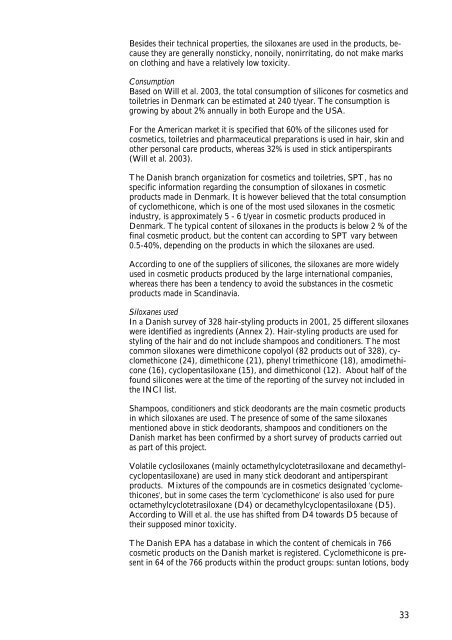No. 1031 - Miljøstyrelsen
No. 1031 - Miljøstyrelsen
No. 1031 - Miljøstyrelsen
You also want an ePaper? Increase the reach of your titles
YUMPU automatically turns print PDFs into web optimized ePapers that Google loves.
Besides their technical properties, the siloxanes are used in the products, because<br />
they are generally nonsticky, nonoily, nonirritating, do not make marks<br />
on clothing and have a relatively low toxicity.<br />
Consumption<br />
Based on Will et al. 2003, the total consumption of silicones for cosmetics and<br />
toiletries in Denmark can be estimated at 240 t/year. The consumption is<br />
growing by about 2% annually in both Europe and the USA.<br />
For the American market it is specified that 60% of the silicones used for<br />
cosmetics, toiletries and pharmaceutical preparations is used in hair, skin and<br />
other personal care products, whereas 32% is used in stick antiperspirants<br />
(Will et al. 2003).<br />
The Danish branch organization for cosmetics and toiletries, SPT, has no<br />
specific information regarding the consumption of siloxanes in cosmetic<br />
products made in Denmark. It is however believed that the total consumption<br />
of cyclomethicone, which is one of the most used siloxanes in the cosmetic<br />
industry, is approximately 5 - 6 t/year in cosmetic products produced in<br />
Denmark. The typical content of siloxanes in the products is below 2 % of the<br />
final cosmetic product, but the content can according to SPT vary between<br />
0.5-40%, depending on the products in which the siloxanes are used.<br />
According to one of the suppliers of silicones, the siloxanes are more widely<br />
used in cosmetic products produced by the large international companies,<br />
whereas there has been a tendency to avoid the substances in the cosmetic<br />
products made in Scandinavia.<br />
Siloxanes used<br />
In a Danish survey of 328 hair-styling products in 2001, 25 different siloxanes<br />
were identified as ingredients (Annex 2). Hair-styling products are used for<br />
styling of the hair and do not include shampoos and conditioners. The most<br />
common siloxanes were dimethicone copolyol (82 products out of 328), cyclomethicone<br />
(24), dimethicone (21), phenyl trimethicone (18), amodimethicone<br />
(16), cyclopentasiloxane (15), and dimethiconol (12). About half of the<br />
found silicones were at the time of the reporting of the survey not included in<br />
the INCI list.<br />
Shampoos, conditioners and stick deodorants are the main cosmetic products<br />
in which siloxanes are used. The presence of some of the same siloxanes<br />
mentioned above in stick deodorants, shampoos and conditioners on the<br />
Danish market has been confirmed by a short survey of products carried out<br />
as part of this project.<br />
Volatile cyclosiloxanes (mainly octamethylcyclotetrasiloxane and decamethylcyclopentasiloxane)<br />
are used in many stick deodorant and antiperspirant<br />
products. Mixtures of the compounds are in cosmetics designated 'cyclomethicones',<br />
but in some cases the term 'cyclomethicone' is also used for pure<br />
octamethylcyclotetrasiloxane (D4) or decamethylcyclopentasiloxane (D5).<br />
According to Will et al. the use has shifted from D4 towards D5 because of<br />
their supposed minor toxicity.<br />
The Danish EPA has a database in which the content of chemicals in 766<br />
cosmetic products on the Danish market is registered. Cyclomethicone is present<br />
in 64 of the 766 products within the product groups: suntan lotions, body<br />
33

















